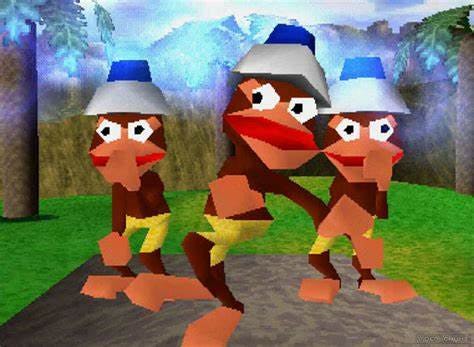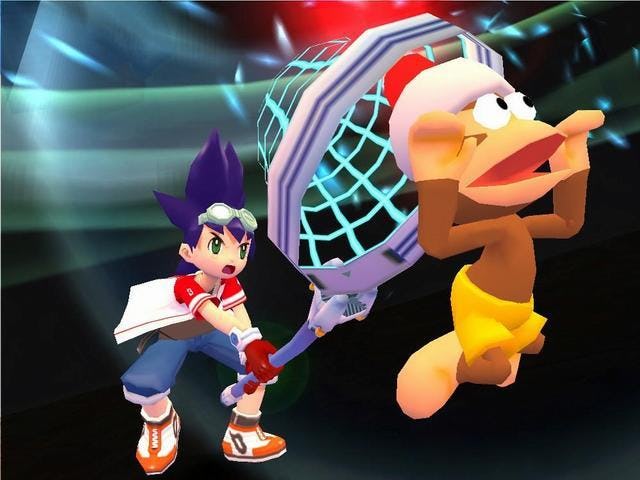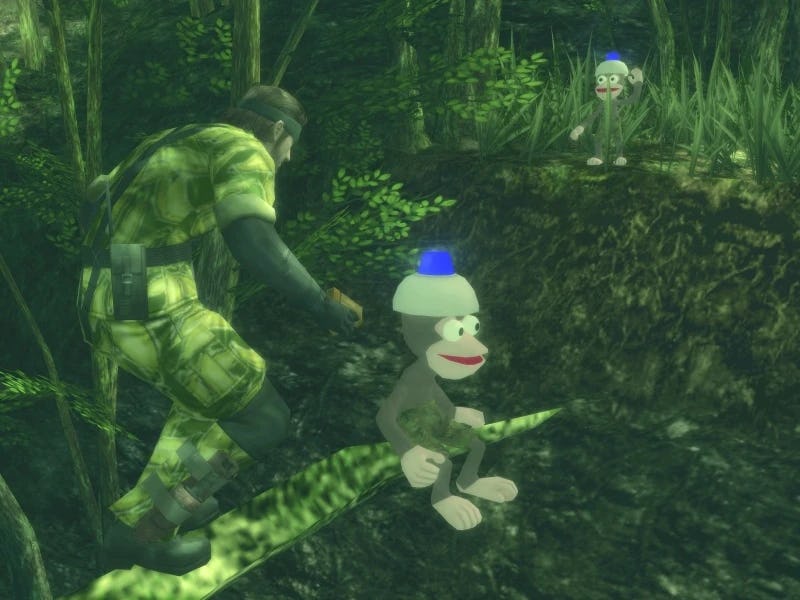
In an era long before PlayStation’s biggest characters were a collection of grizzled, middle-aged dads, there was another tried-and-true method of winning over gaming audiences. Kid-friendly mascot platformers ruled the land, with characters like Mario and Sega’s Blue Blur becoming the medium’s defacto figureheads. While there was no shortage of anthropomorphic dudes with attitude on the platform thanks to third-party studios (a special shout out to Rayman, Crash Bandicoot, and Gex), PlayStation didn’t have one that was entirely their own.
That was until June 1999, when Sony’s Studio Japan finally cracked the cute mascot code with the release of Ape Escape. This charming 3D platformer not only became a major sales success for PlayStation, it helped teach players the ins and outs of a brand-new accessory, helping usher in an industry standard that remains to this day.
Ape Escape has a very simple premise. An albino monkey named Specter stumbles onto a prototype helmet created by the Professor that boosts the intelligence of monkeys. The prototype turns Specter into a mad genius who frees his fellow simians and grants them helmets of their own. It’s Planet Of The Apes meets Dr. Robotnik out there, and it's up to our hero Spike, armed with a series of monkey-catching gadgets, to stop Specter before it's too late.

The game revolves around the player exploring 21 different levels catching mischievous monkeys on the loose. How players catch these monkeys made Ape Escape such an important part of gaming’s history. Ape Escape was only playable with the original DualShock, the first video game controller with two analog sticks.
Nintendo invented and perfected how to move a character in a 3D space three years prior with Super Mario 64. But the DualShock got players outside of the Nintendo ecosystem acquainted with the concept of fine, precision control. Here in the U.S., the DualShock came out almost two years before Ape Escape. Yet Ape Escape was one of the first games on the platform to exploit its full potential.
The game required players to run (or sneak) around with the left analog stick while using the right analog stick to swing their lightsaber-like baton and monkey-catching net in the direction they wanted. This simple yet intuitive control proved to mainstream audiences that the dual stick concept was more than a gimmick to sell new controllers. It was a new standard that gaming hasn’t retreated from since.

The original Ape Escape was praised for such innovation, earning near-perfect scores from media outlets at the time, according to Metacritic. It also helped that the game filled a gap in PlayStation’s library. In PlayStaion’s earliest days, Spike, Professor, Cas, and even Specter and his cast of hilarious monkeys served as the perfect kid-friendly alternative to the more tween-centric characters like Jak, Ratchet, Crash, and Lara Croft.
Japan Studio would follow-up the success of the game with sequels, Ape Escape 2 in 2001 and both Ape Escape 3 and a PSP remake of the original in 2005. In 2006, the monkeys would also make an iconic appearance in the first Metal Gear Solid 3 reissue subtitled Subsistence, in a crossover mode called Snake vs. Monkey. The game even got its own television series both in Japan and the U.S.
During the PS3 era, PlayStation found success in the strong arms of mature leads like Kratos, Nathan Drake, and, uh, Killzone Guy. As a result, the Ape Escape franchise quietly fell into the background. Spike and the gang became more of a novelty, family-friendly representative for the PlayStation brand. The characters would appear in their own spinoff games for the ill-fated PlayStation Move, and were trotted out for the company’s 2012 Smash Bros. clone before being mostly forgotten by audiences.

Though Ape Escape isn’t as popular as it was two decades ago, now would be a great time to revisit the old franchise. Of the three console manufacturers ruling the industry today, Nintendo is the only one that has consistently courted younger audiences over the last 25 years, a key demographic for the medium. It’s a shortcoming PlayStation is clearly trying to make up for, with games like Lego Horizon Adventures and Astro Bot being the company’s tentpole releases this fall (fun fact: Team Asobi, the developer behind Astro Bot and Astro’s Playroom, are a smaller group of developers that spun off from the Ape Escape team). Ape Escape was already a great showcase for the DualShock. It would be great to see how Ape Escape could creatively use the PS5’s DualSense.
As gaming rose through the turn of the century, Ape Escape’s monumental legacy is easily lost to time. But its delightful characters, adorable monkeys, and absurd world are an important and necessary part of PlayStation’s history and success. More importantly, Ape Escape’s primitive but effective use of dual analog sticks helped standardize the modern controller, paving the way for intuitive camera control and even the first-person shooters that dominate the medium today.







